Hydrogen Revolution in Europe: Bibliometric Review of Industrial Hydrogen Applications for a Sustainable Future
Abstract
:1. Introduction
2. Materials and Methods
3. Results
4. Discussion
5. Conclusions
Author Contributions
Funding
Data Availability Statement
Acknowledgments
Conflicts of Interest
References
- Fernández-Arias, P.; Antón-Sancho, Á.; Lampropoulos, G.; Vergara, D. Emerging Trends and Challenges in Pink Hydrogen Research. Energies 2024, 17, 2291. [Google Scholar] [CrossRef]
- Arcos, J.M.M.; Santos, D.M.F. The Hydrogen Color Spectrum: Techno-Economic Analysis of the Available Technologies for Hydrogen Production. Gases 2023, 3, 25–46. [Google Scholar] [CrossRef]
- Falcone, P.M.; Hiete, M.; Sapio, A. Hydrogen economy and sustainable development goals: Review and policy insights. Curr. Opin. Green Sust. Chem. 2021, 31, 100506. [Google Scholar] [CrossRef]
- Alamiery, A. Advancements in materials for hydrogen production: A review of cutting-edge technologies. ChemPhysMater 2024, 3, 64–73. [Google Scholar] [CrossRef]
- Shaner, M.R.; Atwater, H.A.; Lewis, N.S.; Mcfarland, E.W. A Comparative Technoeconomic Analysis of Renewable Hydrogen Production Using Solar Energy. Energy Environ. Sci 2016, 9, 2354. [Google Scholar] [CrossRef]
- Cecere, D.; Giacomazzi, E.; Ingenito, A. A Review on Hydrogen Industrial Aerospace Applications. Int. J. Hydrogen Energy 2014, 39, 10731–10747. [Google Scholar] [CrossRef]
- Wang, C.; Walsh, S.D.C.; Longden, T.; Palmer, G.; Lutalo, I.; Dargaville, R. Optimising Renewable Generation Configurations of Off-Grid Green Ammonia Production Systems Considering Haber-Bosch Flexibility. Energy Convers. Manag. 2023, 280, 116790. [Google Scholar] [CrossRef]
- Humphreys, J.; Lan, R.; Tao, S. Development and Recent Progress on Ammonia Synthesis Catalysts for Haber–Bosch Process. Adv. Energy Sustain. Res. 2021, 2, 2000043. [Google Scholar] [CrossRef]
- Yeh, H.W.; Epstein, S. Hydrogen and Carbon Isotopes of Petroleum and Related Organic Matter. Geochim. Cosmochim. Acta 1981, 45, 753–762. [Google Scholar] [CrossRef]
- Okere, C.J.; Sheng, J.J. Review on Clean Hydrogen Generation from Petroleum Reservoirs: Fundamentals, Mechanisms, and Field Applications. Int. J. Hydrogen Energy 2023, 48, 38188–38222. [Google Scholar] [CrossRef]
- Sadeghi, B.; Cavaliere, P.; Bayat, M.; Ebrahimzadeh Esfahani, N.; Laska, A.; Koszelow, D. Experimental Study and Numerical Simulation on Porosity Dependent Direct Reducibility of High-Grade Iron Oxide Pellets in Hydrogen. Int. J. Hydrogen Energy 2024, 69, 586–607. [Google Scholar] [CrossRef]
- Rieger, J.; Colla, V.; Matino, I.; Branca, T.A.; Stubbe, G.; Panizza, A.; Brondi, C.; Falsafi, M.; Hage, J.; Wang, X.; et al. Residue Valorization in the Iron and Steel Industries: Sustainable Solutions for a Cleaner and More Competitive Future Europe. Metals 2021, 11, 1202. [Google Scholar] [CrossRef]
- Qazi, U.Y. Future of Hydrogen as an Alternative Fuel for Next-Generation Industrial Applications; Challenges and Expected Opportunities. Energies 2022, 15, 4741. [Google Scholar] [CrossRef]
- Reddi, K.; Elgowainy, A.; Rustagi, N.; Gupta, E. Impact of Hydrogen Refueling Configurations and Market Parameters on the Refueling Cost of Hydrogen. Int. J. Hydrogen Energy 2017, 42, 21855–21865. [Google Scholar] [CrossRef]
- Balat, M. Potential Importance of Hydrogen as a Future Solution to Environmental and Transportation Problems. Int. J. Hydrogen Energy 2008, 33, 4013–4029. [Google Scholar] [CrossRef]
- Cipriani, G.; Di Dio, V.; Genduso, F.; La Cascia, D.; Liga, R.; Miceli, R.; Ricco Galluzzo, G. Perspective on Hydrogen Energy Carrier and Its Automotive Applications. Int. J. Hydrogen Energy 2014, 39, 8482–8494. [Google Scholar] [CrossRef]
- Nanmaran, R.; Mageswari, M.; Srimathi, S.; Ganesh Raja, G.; Al Obaid, S.; Ali Alharbi, S.; Elumalai, P.; Thanigaivel, S. Mathematical Modelling of Hydrogen Transportation from Reservoir Tank to Hydrogen Fuel Cell Electric Vehicle (FCEV) Tank. Fuel 2024, 361, 130725. [Google Scholar] [CrossRef]
- Fernández-Arias, P.; Antón-Sancho, Á.; Lampropoulos, G.; Vergara, D. On Green Hydrogen Generation Technologies: A Bibliometric Review. Appl. Sci. 2024, 14, 2524. [Google Scholar] [CrossRef]
- Sadik-Zada, E.R. Political Economy of Green Hydrogen Rollout: A Global Perspective. Sustainability 2021, 13, 13464. [Google Scholar] [CrossRef]
- Barthélémy, H. Hydrogen Storage—Industrial Prospectives. Int. J. Hydrogen Energy 2012, 37, 17364–17372. [Google Scholar] [CrossRef]
- Eberle, U.; Felderhoff, M.; Schüth, F. Chemical and Physical Solutions for Hydrogen Storage. Angew. Chem. Int. Ed. 2009, 48, 6608–6630. [Google Scholar] [CrossRef] [PubMed]
- Züttel, A. Materials for Hydrogen Storage. Mater. Today 2003, 6, 24–33. [Google Scholar] [CrossRef]
- Prabhudessai, V.; Ganguly, A.; Mutnuri, S. Biochemical Methane Potential of Agro Wastes. J. Energy 2013, 2013, 350731. [Google Scholar] [CrossRef]
- Folgado, F.J.; González, I.; Calderón, A.J. PEM Electrolyzer Digital Replica based on internal resistance determination applied to hydrogen energy storage. J. Energy Storage 2024, 75, 109694. [Google Scholar] [CrossRef]
- Xu, Y.; Zhou, Y.; Li, Y.; Ding, Z. Research Progress and Application Prospects of Solid-State Hydrogen Storage Technology. Molecules 2024, 29, 1767. [Google Scholar] [CrossRef]
- Suyambulingam, I.; Sudherson, D.P.S.; Perumal, S.N.; Perumal, S.N. Comprehensive Characterization of Microcrystalline Cellulose from Lemon Grass (Cymbopogan citratus) Oil Extraction Agro-Industrial Waste for Cementitious Composites Applications. Int. J. Biol. Macromol. 2024, 271, 132644. [Google Scholar] [CrossRef]
- Singh, A.; Shivapuji, A.M.; Dasappa, S. Hydrogen Production through Agro-Residue Gasification and Adsorptive Separation. Appl. Therm. Eng. 2023, 234, 121247. [Google Scholar] [CrossRef]
- Saravanan, A.; Kumar, P.S.; Mat Aron, N.S.; Jeevanantham, S.; Karishma, S.; Yaashikaa, P.R.; Chew, K.W.; Show, P.L. A Review on Bioconversion Processes for Hydrogen Production from Agro-Industrial Residues. Int. J. Hydrogen Energy 2022, 47, 37302–37320. [Google Scholar] [CrossRef]
- Buttner, W.J.; Post, M.B.; Burgess, R.; Rivkin, C. An Overview of Hydrogen Safety Sensors and Requirements. Int. J. Hydrogen Energy 2011, 36, 2462–2470. [Google Scholar] [CrossRef]
- Yue, M.; Lambert, H.; Pahon, E.; Roche, R.; Jemei, S.; Hissel, D. Hydrogen Energy Systems: A Critical Review of Technologies, Applications, Trends and Challenges. Renew. Sustain. Energy Rev. 2021, 146, 111180. [Google Scholar] [CrossRef]
- Raman, R.; Nair, V.K.; Prakash, V.; Patwardhan, A.; Nedungadi, P. Green-Hydrogen Research: What Have We Achieved, and Where Are We Going? Bibliometrics Analysis. Energy Rep. 2022, 8, 9242–9260. [Google Scholar] [CrossRef]
- Catumba, B.D.; Sales, M.B.; Borges, P.T.; Ribeiro Filho, M.N.; Lopes, A.A.S.; de Sousa Rios, M.A.; Desai, A.S.; Bilal, M.; dos Santos, J.C.S. Sustainability and Challenges in Hydrogen Production: An Advanced Bibliometric Analysis. Int. J. Hydrogen Energy 2023, 48, 7975–7992. [Google Scholar] [CrossRef]
- Fernández-Arias, P.; Vergara, D.; Antón-Sancho, Á. Bibliometric Review and Technical Summary of PWR Small Modular Reactors. Energies 2023, 16, 5168. [Google Scholar] [CrossRef]
- Hydrogen Demand|European Hydrogen Observatory. Available online: https://observatory.clean-hydrogen.europa.eu/hydrogen-landscape/end-use/hydrogen-demand (accessed on 25 June 2024).
- European Commission. A Hydrogen Strategy for a Climate-Neutral Europe. Available online: https://eur-lex.europa.eu/legal-content/EN/TXT/?uri=CELEX:52020DC0301 (accessed on 17 July 2024).
- European Commission. EU Strategy on Energy System Integration. Available online: https://energy.ec.europa.eu/topics/energy-systems-integration/eu-strategy-energy-system-integration_en (accessed on 17 July 2024).
- Regona, M.; Yigitcanlar, T.; Xia, B.; Li, R.Y.M. Opportunities and Adoption Challenges of AI in the Construction Industry: A PRISMA Review. J. Open Innov. Technol. Mark. Complex. 2022, 8, 45. [Google Scholar] [CrossRef]
- Cortese, T.T.P.; de Almeida, J.F.S.; Batista, G.Q.; Storopoli, J.E.; Liu, A.; Yigitcanlar, T. Understanding Sustainable Energy in the Context of Smart Cities: A PRISMA Review. Energies 2022, 15, 2382. [Google Scholar] [CrossRef]
- Pahlevan Sharif, S.; Mura, P.; Wijesinghe, S.N.R. Systematic Reviews in Asia: Introducing the “PRISMA” Protocol to Tourism and Hospitality Scholars. Perspect. Asian Tour. 2019, Part F184, 13–33. [Google Scholar] [CrossRef]
- Moher, D.; Stewart, L.; Shekelle, P. Implementing PRISMA-P: Recommendations for Prospective Authors. Syst Rev 2016, 5, 1–2. [Google Scholar] [CrossRef] [PubMed]
- Trovarelli, A. Catalytic Properties of Ceria and CeO2-Containing Materials. Catal. Rev. 1996, 38, 439–520. [Google Scholar] [CrossRef]
- Mueller, U.; Schubert, M.; Teich, F.; Puetter, H.; Schierle-Arndt, K.; Pastré, J. Metal–Organic Frameworks—Prospective Industrial Applications. J. Mater. Chem. 2006, 16, 626–636. [Google Scholar] [CrossRef]
- Popov, V.N. Carbon Nanotubes: Properties and Application. Mater. Sci. Eng. R Rep. 2004, 43, 61–102. [Google Scholar] [CrossRef]
- Kondratenko, E.V.; Mul, G.; Baltrusaitis, J.; Larrazábal, G.O.; Pérez-Ramírez, J. Status and Perspectives of CO2 Conversion into Fuels and Chemicals by Catalytic, Photocatalytic and Electrocatalytic Processes. Energy Environ. Sci. 2013, 6, 3112–3135. [Google Scholar] [CrossRef]
- Erdemir, A.; Donnet, C. Tribology of Diamond-like Carbon Films: Recent Progress and Future Prospects. J. Phys. D Appl. Phys. 2006, 39, R311. [Google Scholar] [CrossRef]
- Welton, T. Ionic Liquids: A Brief History. Biophys. Rev. 2018, 10, 691–706. [Google Scholar] [CrossRef] [PubMed]
- Cametti, M.; Rissanen, K. Recognition and Sensing of Fluoride Anion. Chem. Commun. 2009, 20, 2809–2829. [Google Scholar] [CrossRef] [PubMed]
- Nikolova, M.P.; Chavali, M.S. Recent Advances in Biomaterials for 3D Scaffolds: A Review. Bioact. Mater. 2019, 4, 271–292. [Google Scholar] [CrossRef] [PubMed]
- De Vos, R.M.; Verweij, H. High-Selectivity, High-Flux Silica Membranes for Gas Separation. Science 1998, 279, 1710–1711. [Google Scholar] [CrossRef] [PubMed]
- Bewilogua, K.; Hofmann, D. History of Diamond-like Carbon Films—From First Experiments to Worldwide Applications. Surf. Coat. Technol. 2014, 242, 214–225. [Google Scholar] [CrossRef]
- Johnson, E.A. Biotechnology of non-Saccharomyces yeasts—The ascomycetes. Appl. Microbiol. Biotechnol. 2013, 97, 503–517. [Google Scholar] [CrossRef] [PubMed]
- Toribio, J.; Vergara, D.; Lorenzo, M. Role of In-Service Stress and Strain Fields on the Hydrogen Embrittlement of the Pressure Vessel Constituent Materials in a Pressurized Water Reactor. Eng. Fail. Anal. 2017, 82, 458–465. [Google Scholar] [CrossRef]
- RMI. The Value of Green Hydrogen Trade for Europe. Available online: https://rmi.org/insight/the-value-of-green-hydrogen-trade-for-europe/ (accessed on 17 July 2024).
- Hydrogen Europe. European Hydrogen Bank Pilot Auction Results Spark Renewable Hydrogen Competitiveness. Available online: https://hydrogeneurope.eu/european-hydrogen-bank-pilot-auction-results-spark-renewable-hydrogen-competitiveness/ (accessed on 17 July 2024).
- McKinsey & Company. Hydrogen Trade Outlook: 2023 Update. Available online: https://www.mckinsey.com/industries/oil-and-gas/our-insights/oil-and-gas-blog/hydrogen-trade-outlook-2023-update (accessed on 17 July 2024).
- Zainal, B.S.; Ker, P.J.; Mohamed, H.; Ong, H.C.; Fattah, I.M.R.; Rahman, S.M.A.; Nghiem, L.D.; Mahlia, T.M.I. Recent advancement and assessment of green hydrogen production technologies. Renew. Sustain. Energy Rev. 2024, 189, 113941. [Google Scholar]
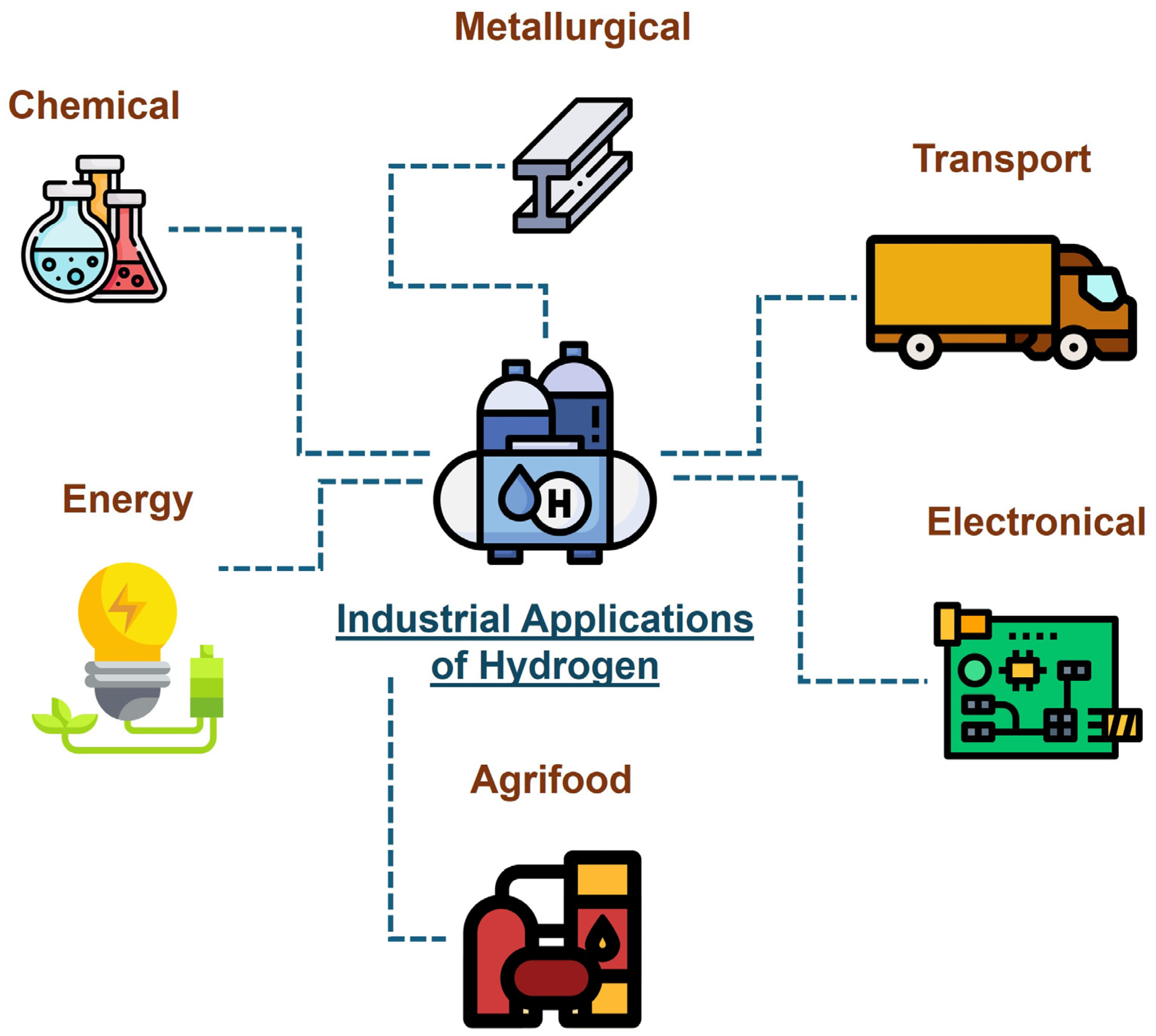
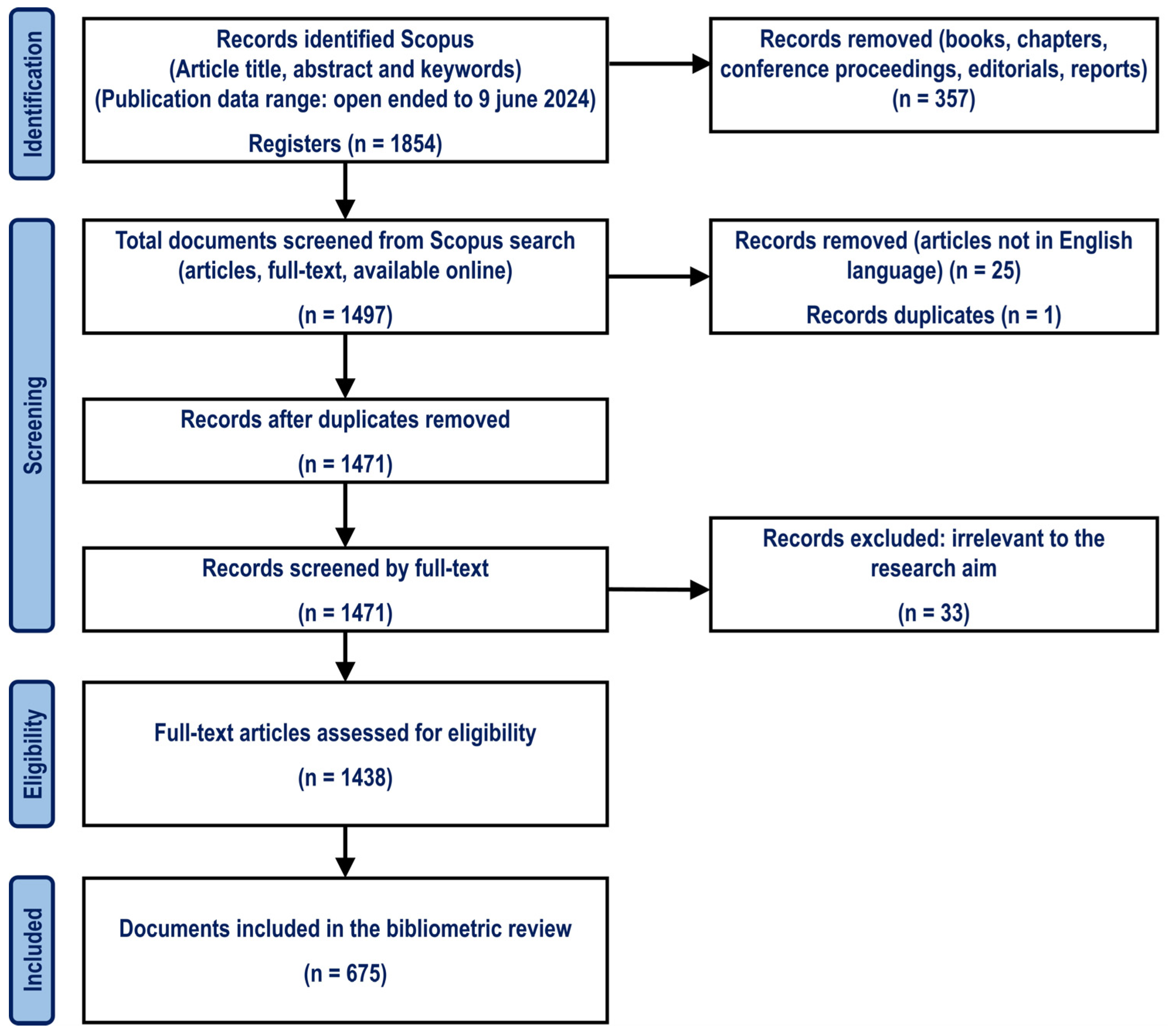
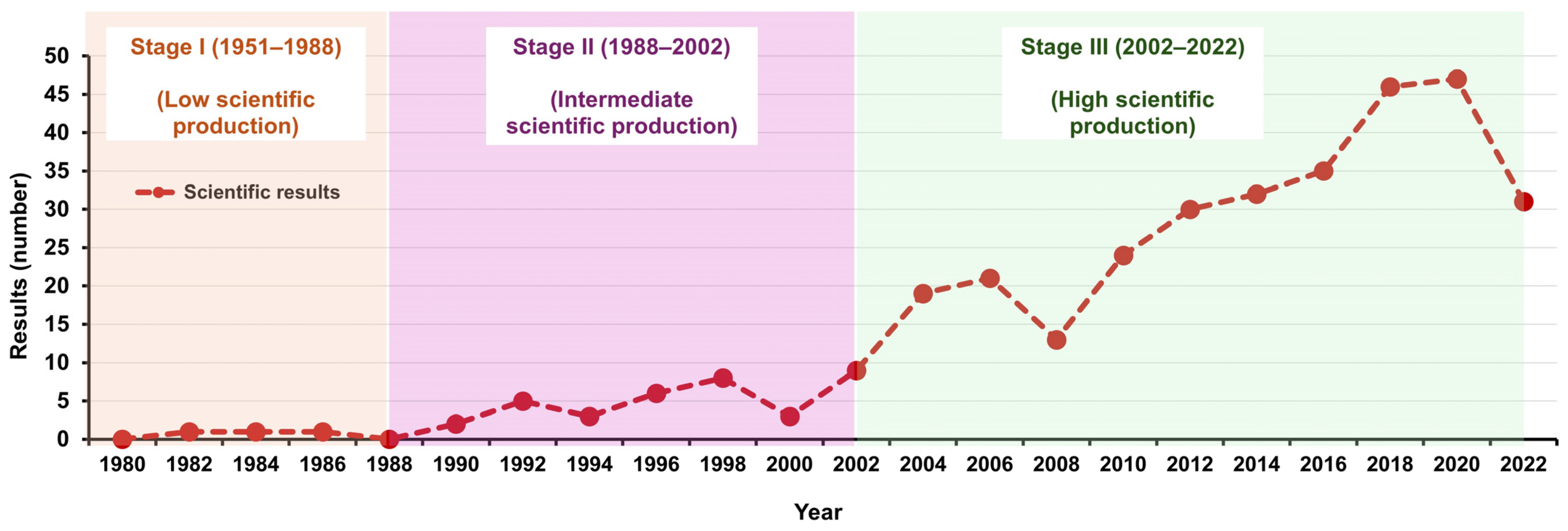

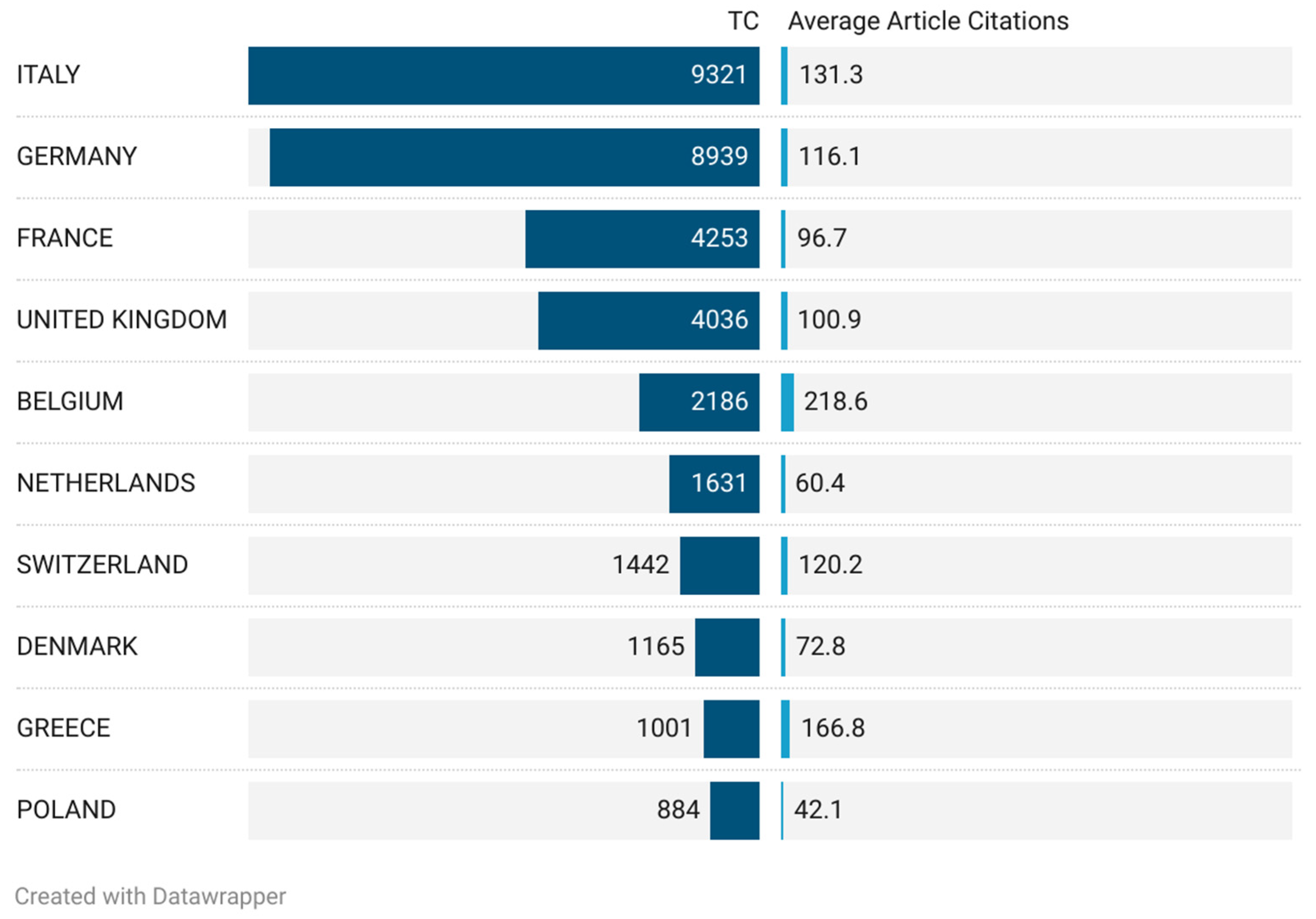

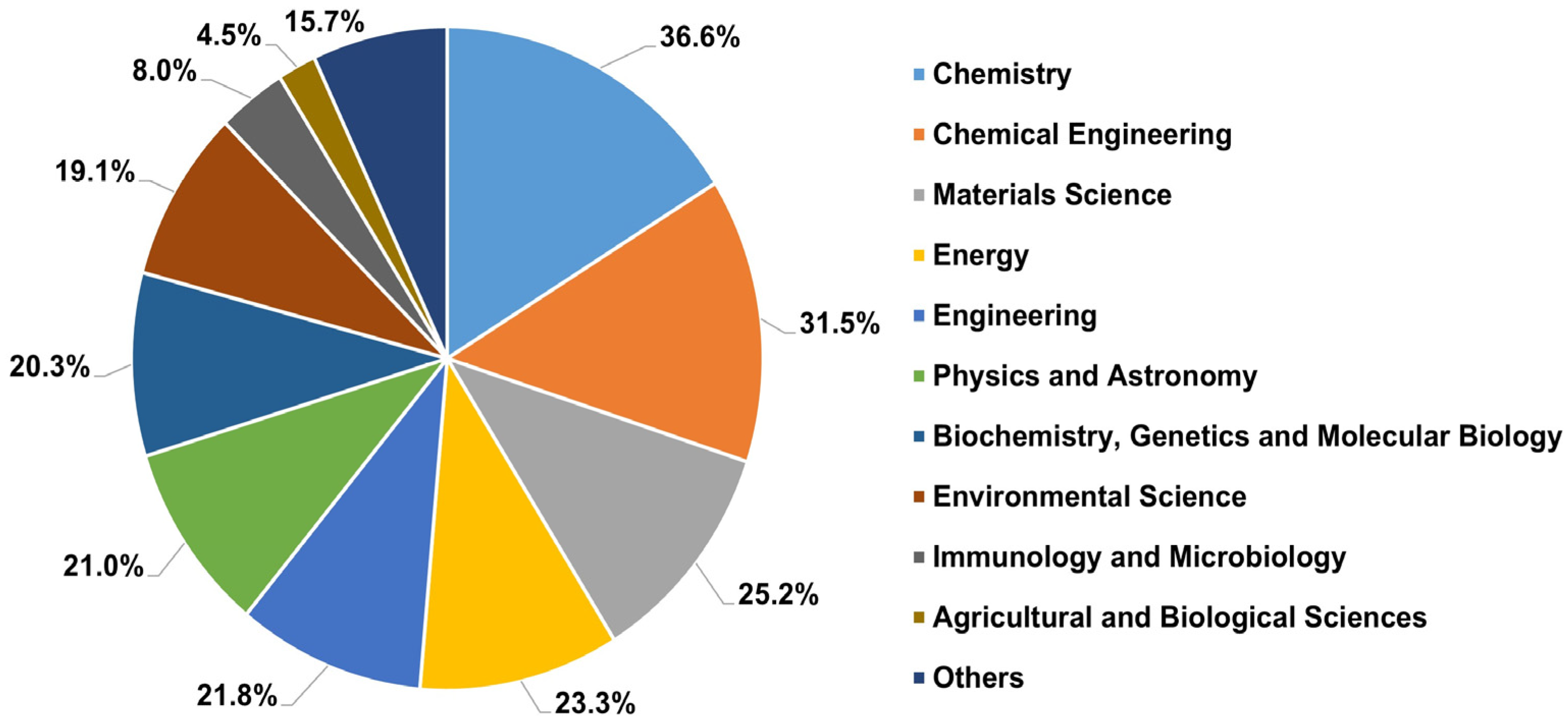
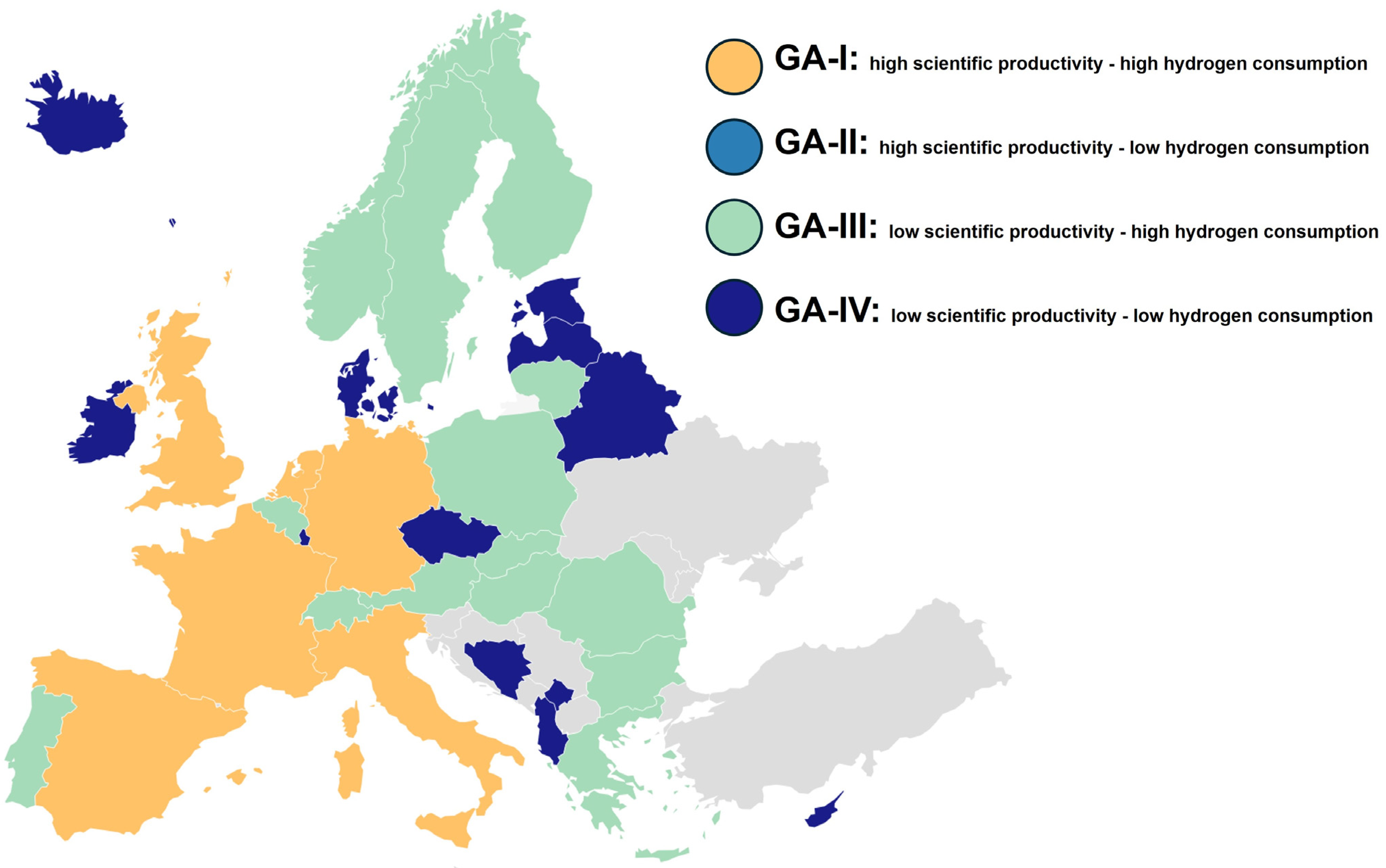

| Description | Results |
|---|---|
| Main information about data | |
| Timespan | 1951–2023 |
| Sources (Journals, Books, etc.) | 329 |
| Documents | 675 |
| Annual Growth Rate % | 3.63 |
| Document Average Age | 11.9 |
| Average citations per doc | 89.85 |
| References | 0 |
| Document contents | |
| Keywords Plus (ID) | 7782 |
| Author’s Keywords (DE) | 2118 |
| Authors | |
| Authors | 3169 |
| Authors of single-authored docs | 22 |
| Authors collaboration | |
| Single-authored docs | 22 |
| Co-Authors per Doc | 5.14 |
| International co-authorships % | 44.44 |
| Document types | |
| article | 553 |
| conference paper | 12 |
| letter | 1 |
| review | 108 |
| short survey | 1 |
| Sources | Results |
|---|---|
| International Journal of Hydrogen Energy | 32 |
| Surface and Coatings Technology | 18 |
| Applied Microbiology and Biotechnology | 13 |
| Industrial and Engineering Chemistry Research | 13 |
| Chemical Engineering Journal | 11 |
| Chemsuschem | 9 |
| Journal of Biotechnology | 9 |
| Acs Applied Materials and Interfaces | 8 |
| chemical engineering science | 8 |
| renewable and sustainable energy reviews | 8 |
| Paper | Reference | Total Citations | TC per Year | Normalized TC |
|---|---|---|---|---|
| Trovarelli, A. (1996) | [41] | 3326 | 114.69 | 5.50 |
| Mueller, U. (2006) | [42] | 2046 | 107.68 | 9.14 |
| Popov, V.N. (2004) | [43] | 1735 | 82.62 | 8.16 |
| Kondratenko, E.V. (2013) | [44] | 1491 | 124.25 | 14.82 |
| Erdemir, A. (2006) | [45] | 1054 | 55.47 | 4.71 |
| Welton, T. (2018) | [46] | 664 | 94.86 | 8.28 |
| Cametti, M. (2009) | [47] | 628 | 39.25 | 6.21 |
| Chavali, M.S. (2019) | [48] | 575 | 95.83 | 10.51 |
| de Vos, R.M. (1998) | [49] | 555 | 20.56 | 2.62 |
| Bewilogua, K. (2014) | [50] | 462 | 42.00 | 5.35 |
| Documents Written | No. of Authors | Proportion of Authors |
|---|---|---|
| 1 | 2938 | 92.71% |
| 2 | 188 | 5.93% |
| 3 | 29 | 0.92% |
| 4 | 9 | 0.28% |
| 5 | 2 | 0.06% |
| 6 | 1 | 0.03% |
| 7 | 1 | 0.03% |
| 8 | 1 | 0.03% |
| Position | Affiliation | Country | Articles |
|---|---|---|---|
| 1 | Technical University of Denmark | Denmark | 49 |
| 3 | University of Porto | Portugal | 25 |
| 4 | Aarhus university | Denmark | 22 |
| 5 | Politecnico di Milano | Italy | 22 |
| 6 | Abo Akademi university | Finland | 22 |
| 7 | Delft university of technology | The Netherlands | 18 |
| 8 | Rwth Aachen University | Germany | 18 |
| 9 | University of Twente | Netherlands | 17 |
| Position | Keyword | Occurrences | Total Link Strength |
|---|---|---|---|
| 1 | hydrogen-ion concentration | 117 | 3271 |
| 2 | Nonhuman | 105 | 3145 |
| 3 | pH | 109 | 3116 |
| 4 | Chemistry | 96 | 2497 |
| 5 | Metabolism | 80 | 2263 |
| 6 | industrial applications | 140 | 2190 |
| 7 | Temperature | 82 | 2066 |
| 8 | priority journal | 84 | 2003 |
| 9 | enzyme activity | 55 | 1928 |
| 10 | unclassified drug | 60 | 1778 |
| Industrial Application | Additional Search String | Results | Countries |
|---|---|---|---|
| Chemical | AND (“Ammonia” OR “Methanol” OR “refining” OR “blending” OR “Chemi *”) | 770 | Germany, United Kingdom, Spain, France, Italy |
| Metallurgical | AND (“Steel” OR “iron”) | 154 | Germany, United Kingdom, Spain, France, Italy, Poland |
| Transport | AND (“movility” OR “transport” OR “cell”) | 324 | Germany, United Kingdom, Spain, France, Italy and Netherlands |
| Energy | AND (“energy” OR “generation” OR “electricity”) | 533 | Germany, United Kingdom, Spain, France, Italy and Netherlands |
| Agrifood | AND (“fertilizers” OR “agro *” OR “agricu *”) | 50 | Germany, United Kingdom, Poland, Italy, Portugal and Greece |
| Electronical | AND (“electronical” OR “electro *”) | 452 | Germany, United Kingdom, Spain, France, Italy, Poland |
Disclaimer/Publisher’s Note: The statements, opinions and data contained in all publications are solely those of the individual author(s) and contributor(s) and not of MDPI and/or the editor(s). MDPI and/or the editor(s) disclaim responsibility for any injury to people or property resulting from any ideas, methods, instructions or products referred to in the content. |
© 2024 by the authors. Licensee MDPI, Basel, Switzerland. This article is an open access article distributed under the terms and conditions of the Creative Commons Attribution (CC BY) license (https://creativecommons.org/licenses/by/4.0/).
Share and Cite
Vergara, D.; Fernández-Arias, P.; Lampropoulos, G.; Antón-Sancho, Á. Hydrogen Revolution in Europe: Bibliometric Review of Industrial Hydrogen Applications for a Sustainable Future. Energies 2024, 17, 3658. https://doi.org/10.3390/en17153658
Vergara D, Fernández-Arias P, Lampropoulos G, Antón-Sancho Á. Hydrogen Revolution in Europe: Bibliometric Review of Industrial Hydrogen Applications for a Sustainable Future. Energies. 2024; 17(15):3658. https://doi.org/10.3390/en17153658
Chicago/Turabian StyleVergara, Diego, Pablo Fernández-Arias, Georgios Lampropoulos, and Álvaro Antón-Sancho. 2024. "Hydrogen Revolution in Europe: Bibliometric Review of Industrial Hydrogen Applications for a Sustainable Future" Energies 17, no. 15: 3658. https://doi.org/10.3390/en17153658







